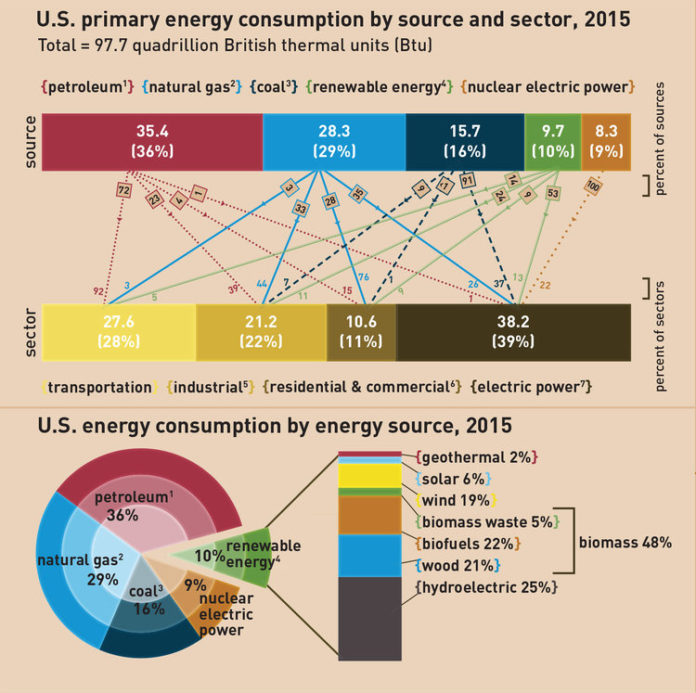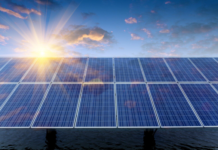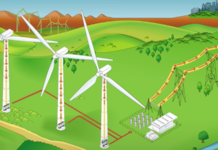
Blowin’ in the Wind
Question: How much of the energy we use comes from fossil fuels?
The Right Question: How much of the energy we use is dependent on fossil fuels?
Last month we identified the sources of energy that make our high-technology civilization possible.
What it really comes down to is fossilized sunlight, energy initially captured by photosynthesis, and fashioned into coal, oil and natural gas over many millions of years. Thinking about human culture as a system for capturing energy to support increasing populations of our kind on the planet, there have been two changes that stand out in our several-hundred-thousand-year history as true watershed moments. The first was agriculture, developed independently in several parts of the world between 8,000 and 12,000 years ago. The second was the exploitation of fossil fuels, initially through steam engines, just over 300 years ago.
In the preceding 12 millennia, human population crept up at a very slow rate, with only arithmetic increases based on incremental changes in technology and the expansion of the territory dedicated to agriculture. The surplus energy available from agriculture changed only very slightly for thousands of years. Global population several times dropped from one century to the next. Dozens of generations of people lived such that their lifestyle would have been very familiar to their great-great-great-great-great-great-grandparents. It took 10,000 years for human population to reach one half-billion, shortly before 1700.
With the fossil fuel revolution, all hell broke loose. The incredible quantities of energy available allowed exponential increases in population and consumption. Global population doubled from 3 billion to 6 billion in just 40 years, from 1960 to 2000, as energy from fossil fuels also doubled.
So exactly what part of our current energy consumption comes from fossil fuels, and how do we use them?
Two charts generated and updated regularly by the Energy Information Administration can provide us some important background and context.
We can see that renewable energy from wind and solar are 2.4 percent of our total energy use, and 6 percent of our electricity use. Together, wind, solar and hydro—the renewable technologies used for electricity—generate 12 percent of our electricity. The rest comes mostly from natural gas and coal.
We can see that our transportation system is 95 percent dependent on fossil fuels. In the case of freight transportation, not broken out in this chart, it is virtually 100 percent.
Unfortunately, most of the modern renewable energy technologies are completely dependent on fossil fuel energy subsidies, and, without them, they are nearly impossible to carry out.
Consider the fossil fuel needed to construct a modern, 1.5 megawatt capacity wind turbine. The materials needed for these turbines often originate on two or three continents and are moved to their assembly point in ships, trucks and trains. The efficiency of the turbine depends on highly technical electronic controls. Rare metals sourced from around the globe are crucial. Large amounts of steel and concrete are needed, and the manufacture of concrete requires burning fossil fuel and releases substantial carbon dioxide from the concrete itself. Finally, the turbine must be transported to its final location and erected.
Often, the size of components requires specially built rail cars and trucks. Then, there are the diesel-powered cranes and other heavy equipment used in the installation. Electric-powered technology for most of these construction processes is nonexistent.
Much the same could be said for photovoltaic arrays. To achieve the recent improvements in the capture of energy, more very-scarce resources are used, and the electronics are equally complex. While not as physically massive as wind turbines, their complexity means they require a great deal of maintenance.
Since both of these sources of energy are intermittent, even for the electricity they supply, they must be integrated into a grid that has fossil fuel capacity—mainly gas and coal-fired generators—to keep the electricity flowing even when it is dark or calm.
Could a reliable electric generation system be based on wind and photovoltaic energy? Could such a system generate electricity to power sectors of society that are completely nonelectrified at present?
by: Jerry Silberman
Source: gridphilly.com


















